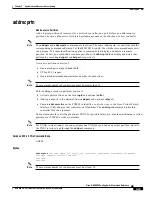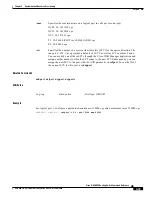
3-27
Cisco MGX 8850 Routing Switch Command Reference
Release 2.0, Part Number 78-10467-04 Rev C0, October 2001
Chapter 3
Equipment and Resource Provisioning
cnfcdsct
cnfcdsct
Configure Card SCT
Assign a service class template (SCT) to an AXSM at the card level. The template contains bandwidth
and policing parameters for an AXSM.
Note
Currently, the system does not support certain parameters in the service class templates (SCTs), so
you can specify them through addcon, cnfcon, or Cisco WAN Manager.
These parameters are (when applicable) PCR, SCR, and ICR.
Usage Guidelines
The cnfcdsct command is card level because it applies to the card’s interface to the backplane. (See
addport for specifying an SCT for a port.) The following characteristics apply to cnfcdsct.
•
A valid SCT file must exist on the PXM45 disk before you execute cnfcdsct. To see a list of SCT
files on the disk, execute cd to get to the SCT directory, then execute ls to see the directory named
AXSM.
•
You must execute cnfcdsct only when the card is down.
•
You cannot change the SCT configuration if any ports, lines, or partitions are configured.
•
To see the ID of the current SCT, use dspcd for the card-level SCT or dspport for a port-level SCT.
•
To see the actual contents of SCT 2 and SCT 3, use dspcdsct.
Background
The node supports a template approach to specifying parameters for large numbers of connections. (You
can modify an individual connection as needed through cnfcon.) The name of such a template is service
class template (SCT). The targets of template application are the logical ports on the one hand and the
card itself on the other. The addport command lets you specify an SCT for a port, and cnfcdsct lets you
specify an SCT for the card. You can specify the same or different SCT number for either the port or
card-level, but you definitely need to specify an SCT for each card and port. The system automatically
assigns a card-level SCT to a card or a port-level SCT of the same number to a port. (For example, if
you specify SCT 2 for a port, the system does not assign card-level SCT 2 to that port.)
Cisco Systems provides SCT numbers 2 and 3. SCT 2 contains policing parameters, but SCT 3 does not.
You should specify SCT 2 or 3 or create new templates by modifying SCT 2 or 3 in the Cisco WAN
Manager application and saving them with different SCT numbers in the range 1–255.
Until you specify an SCT, the AXSM has a default SCT of 0. The system uses SCT 0 when:
•
The AXSM is powered-up for the first time.
•
The card’s database is rebuilt.
•
The card is rebooted and the user-specified SCT file for a particular port is corrupt or missing. In
this situation, the default applies to only the affected port.
Cards on Which This Command Runs
AXSM
















































